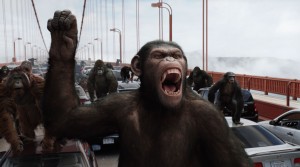RISE OF THE PLANET OF THE APES: 3 STARS
 Earlier this year a documentary called “Project Nim” detailed the life and sad times of Nim Chimpsky, who was taken from his mother and taught sign language before being abandoned once he outlived his usefulness as a laboratory experiment. It would make a good double bill with “Rise of the Planet of the Apes,” a big budget prequel to the famous sci fi films. Man does ape wrong in “Project Nim,” and in “Rise of the Planet of the Apes” the chimps get even.
Earlier this year a documentary called “Project Nim” detailed the life and sad times of Nim Chimpsky, who was taken from his mother and taught sign language before being abandoned once he outlived his usefulness as a laboratory experiment. It would make a good double bill with “Rise of the Planet of the Apes,” a big budget prequel to the famous sci fi films. Man does ape wrong in “Project Nim,” and in “Rise of the Planet of the Apes” the chimps get even.
The time is modern day San Francisco. James Franco plays Will Rodman, a scientist working to create a drug that will slow, or even reverse the effects of Alzheimer’s disease. When one of his chimp test subjects goes berserk the project is shut down and the remaining apes are ordered euthanized “in the most cost effective way possible” by Rodman’s boss, the ruthless CEO Steven Jacobs (David Oyelowo). The scientist rescues a baby chimp, the son of one of his test subjects. Soon he discovers that the drug given to the baby’s mother has filtered through his system, giving him extraordinary intelligence. Raised completely by humans the chimp, named Caesar (after the emperor, not the salad), doesn’t realize he has simian cousins until he is removed from his comfortable home and placed in an ape sanctuary. Soon Caesar becomes like Chimp Guevara, organizing a revolution against his human captors. This ape is mad as hell and he’s not going to take it anymore.
The original “Planet of the Apes” movie was an allegory for racism and nuclear war topped off with Charlton Heston’s hairy chest and some cool monkey masks. “Rise,” on the other hand is a generic action movie with state-of-the-art primates and the occasional moment that elevates it above Tim Burton’s remake, but it doesn’t come close to the emotional realism that made the first movie a classic.
Andy Serkis’s performance-capture work as alpha ape Ceasar is one of the movie’s strengths and weaknesses. There is no doubt that his facial expressions, particularly the use of his eyes, add much to the character of the chimp but the computer generated imagery used to bring Caesar to life, while impressive, lacks an organic feel. It seems fake even though much has been done to ensure a lifelike visage. The Roddy McDowell era apes were obviously fake—sometimes painfully so—but somehow they had more soul.
Emotional apes aside, the movie plays it a bit too cute in the beginning, but when the revolution begins—Caesar uses cookies to bribe his fellow apes into joining him, proving once and for all that an army does indeed march on its stomach—the movie kicks into gear. Some of the action is a bit too showy—since when can apes do martial arts?—but the scene of Caesar on horseback leading the charge against the heavily fortified cops is a real crowd pleaser.
“Rise of the Planet of the Apes” plays fast and loose with the mythology established in the previous movies and takes a bit too long to get to the movie’s exciting monkey business, but delivers an exciting finale that would make Nim proud.
